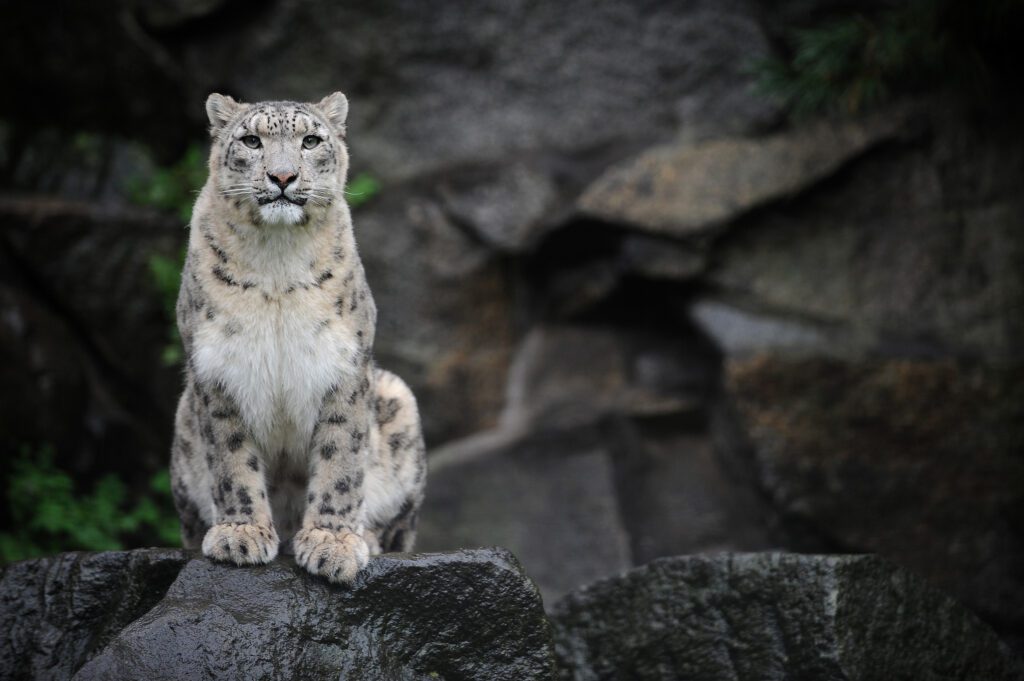"Ghost of the mountain"
Known as the “ghost of the mountain”, this solitary, thick-furred cat is an opportunistic predator occurring in the high mountains of the Tibetan Plateau, Himalaya and other surrounding mountain ranges, including Tian Shan, Hindu Kush, Pamir, Kunlun, Altai, and Hengduan. Adapted to high altitude areas with low temperatures, their distribution coincides closely with their prey which are mainly ungulates including Asiatic ibex and argali sheep. Because of its sporadic distribution and secretive nature, the current population size of snow leopards remains uncertain. The International Union for Conservation of Nature (IUCN) has classified the species as Vulnerable with an estimated number of 3,500 – 7,500 individuals. The population is currently decreasing in some areas, and stable or slightly increasing in others. Additionally, snow leopards have been designated under Appendix I of CMS, which requires range states to take strict measures to protect them by prohibiting their removal, conserving their habitats, removing obstacles to their migration, and mitigating other threats that might endanger them, with only limited exceptions allowed. Under CITES the species is also listed under Appendix I, covering endangered species where all international trade is prohibited.
|
Flagship species |
IUCN Red List (<year of assessment>) |
KAZ Red Book (1999) |
KGZ Red Book (2006) |
TJK Red Book (2015) |
Approx. population size in the project region |
|
Snow Leopard Panthera uncia |
Vulnerable (2016) |
Listed |
Listed |
Listed |
100-120 (KAZ) 300-350 (KGZ) 250-280 (TJK) |
Distribution and habitat
Snow leopards inhabit the mountainous regions of 12 countries in Central and South Asia: Afghanistan, Bhutan, China, India, Kazakhstan, Kyrgyzstan, Mongolia, Nepal, Pakistan, the Russian Federation, Tajikistan, and Uzbekistan. Preferring steep and highly rugged habitats with low vegetation, the snow leopard lives at elevations of below 1000 to above 5000 m. They favour rugged, steep terrain and rocky outcrops, often migrating to lower elevations during winter to avoid deep snow. As habitats become more fragmented from human activities, the remaining populations of snow leopards become more isolated increasing the risk of local extinctions.
Snow leopards are found in the mountainous regions of Kazakhstan, primarily in the eastern part of the country in the Altai and Tien Shan mountain ranges. In Kyrgyzstan, suitable snow leopard habitat covers 89,000 km2 in the Northern, Central, Western Tien Shan and Pamir-Alai ridges. Tajikistan has an 85,700 km2 habitat for snow leopards and serves as a vital corridor for the genetic interchange between southern and northern range populations.
Importance
Within their range, snow leopards are considered a keystone species meaning that they play an important role in maintaining biological integrity in mountain ecosystems. Being a top predator with a wide range, the fate of the snow leopard depends on the populations of its prey species – wild sheep, goats, and other herbivores – and thus is considered an indicator of healthy mountain ecosystems. Measures taken to protect the snow leopard can, therefore, help protect many other species inhabiting the same area.

Threats
Many existing threats to snow leopard populations are exacerbated by climate change. Rising global temperatures are quickly altering the productivity and physical environment of alpine habitats. Increased human activity, poaching, and competition with livestock, threaten the snow leopard’s prey species especially in the light of declining numbers and more fragmented distribution.
Overgrazing largely driven by increasing numbers of livestock, poor grazing management, and climate change, ultimately alters plant community structure and decrease the quality of mountain pastures that are used by both wildlife and livestock. As the availability of wild prey declines, snow leopards start to prey more upon domestic livestock, leading to increased human-wildlife conflicts where snow leopards are often killed in retaliation. With fragmented distribution, the concern about genetic isolation is amplified. Snow leopards are also threatened by poaching, with their bones and fur highly sought after for illegal trade.
Bellamy J.J., Akhmedova T., (2020). Conservation and Sustainable Use of Pamir Alay and Tien Shan Ecosystems for Snow Leopard Protection and Sustainable Community Livelihoods. United Nations Development Programme (UNDP). Tajikistan (PIMS 5437)
J. Li, T.M. McCarthy, H. Wang, B.v. Weckworth, G.B. Schaller, C. Mishra, Z. Lu, S.R. Beissinger. Climate refugia of snow leopards in High Asia. Biol. Conserv., 203 (2016), pp. 188-196, 10.1016/j.biocon.2016.09.026
J. Li, B.V. Weckworth, T.M. McCarthy, X. Liang, Y. Liu, R. Xing, D. Li, Y. Zhang, Y. Xue, R. Jackson, L. Xiao, C. Cheng, S. Li, F. Xu, M. Ma, X. Yang, K. Diao, Y. Gao, D. Song, K. Nowell, B. He, Y. Li, K. McCarthy, M.Y. Paltsyn, K. Sharma, C. Mishra, G.B. Schaller, Z. Lu, S.R. Beissinger. Defining priorities for global snow leopard conservation landscapes. Biol. Conserv., 241 (2020), Article 108387
Li, X.; Ma, L.; Hu, D.; Ma, D.; Li, R.; Sun, Y.; Gao, E. Potential Range Shift of Snow Leopard in Future Climate Change Scenarios. Sustainability 2022, 14, 1115. https://doi.org/10.3390/su14031115
W. Rashid, J. Shi, I. ur Rahim, H. Sultan, S. Dong, L. Ahmad. Research trends and management options in human-snow leopard conflict. Biol. Conserv., 242 (2020), Article 108413, 10.1016/j.biocon.2020.108413
Sharief A, Kumar V, Singh H, Mukherjee T, Dutta R, Joshi BD, et al. (2022) Landscape use and co-occurrence pattern of snow leopard (Panthera uncia) and its prey species in the fragile ecosystem of Spiti Valley, Himachal Pradesh. PLoS ONE 17(7): e0271556. https://doi.org/10.1371/journal.pone.0271556
Snow Leopard Working Secretariat. 2013. Global Snow Leopard and Ecosystem Protection Program Bishkek, Kyrgyz Republic.
Snow Leopard Working Secretariat. 2020. Global Snow Leopard and Ecosystem Protection Program ,Country Updates 2020, Kyrgyz Republic.
Uncia uncia | CMS – https://www.cms.int/en/species/uncia-uncia

